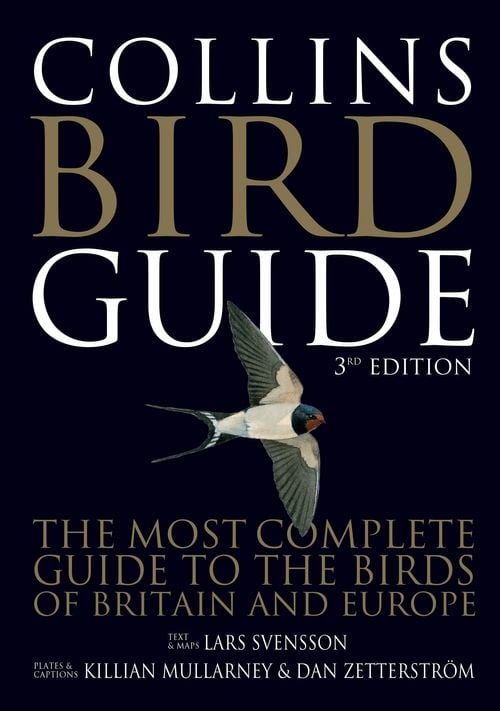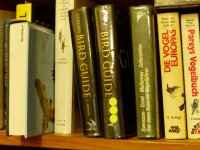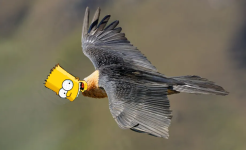News flash: that's how taxonomy and nomenclature work.I am irritated by . . . the statement that taxonomy, and also English names, are 'Author's choice'.
-
Welcome to BirdForum, the internet's largest birding community with thousands of members from all over the world. The forums are dedicated to wild birds, birding, binoculars and equipment and all that goes with it.
Please register for an account to take part in the discussions in the forum, post your pictures in the gallery and more.
You are using an out of date browser. It may not display this or other websites correctly.
You should upgrade or use an alternative browser.
You should upgrade or use an alternative browser.
New edition of Fågelguiden (Collins Bird Guide). (1 Viewer)
- Thread starter nkbj
- Start date
More options
Who Replied?James Jobling
Well-known member

I had noticed that some of the texts appear unidiomatic, as if strictly translated from Swedish, and was disappointed to see Loon still used in preference to Diver. Since loon is a term of reproach or mild abuse, I’m surprised some hand-wringer hasn’t taken offence.

I am taking much more offence by the fact that Bearded Vulture still runs under the name Lammergeier, a name that originally helped to drive the species to extinction im much of Europe.I had noticed that some of the texts appear unidiomatic, as if strictly translated from Swedish, and was disappointed to see Loon still used in preference to Diver. Since loon is a term of reproach or mild abuse, I’m surprised some hand-wringer hasn’t taken offence.

As a stopgap measure, I marked my 3rd edition with three conspicuous yellow dots. But that is definitely not my preferred way of dealing with a new book. But then, discarding the older book is not what I plan to do either.
Attachments
WRL
Well-known member

Weird. In the (still current, second) German edition "Lämmergeier" it is not even mentioned. It is named "Bartgeier" (Bearded Vulture). Same designation in Lars Gejl's book on raptors (second German edition).I am taking much more offence by the fact that Bearded Vulture still runs under the name Lammergeier, a name that originally helped to drive the species to extinction im much of Europe.
James Jobling
Well-known member

Swissboy, you too have obviously received your copy of the splendid “The Bird Name Book”, by Susan Myers (Princeton 2022) and read the ‘Lammergeier’ article on p. 195 — if the bureaucrats are against Lammergeier, I am for it. Lammergeier, in the spelling Lammergeyer, was first used as an English word in 1817 (SOED, 1950, I, p. 1101). The days when Lammergeiers carted off sheep, goats, infants and their little dogs, thankfully are long gone. But this reputation amongst the uneducated and superstitious rural populations of central Europe obviously did not endear the bird to shepherds and stockmen. The same could be said of any raptor whose habits, real or imagined, collided with a burgeoning human population. Should we spurn Hen Harrier or Goshawk? Nevertheless, I like the unique name Lammergeier; I doubt if more than 40% of British birdwatchers know the origin of the name, and the rest don’t care – provided they can add it to their life-lists.
May I wish you and all readers on BirdForum a very Merry Christmas.
James
May I wish you and all readers on BirdForum a very Merry Christmas.
James

It's no problem in the German versions. But the discriminating name does not disappear as long as it is still in common use in the most widespread scientific language.Weird. In the (still current, second) German edition "Lämmergeier" it is not even mentioned. It is named "Bartgeier" (Bearded Vulture). Same designation in Lars Gejl's book on raptors (second German edition).

I don't need that book to know what I am writing about. Of course, the name was originally also the common German name. But in that language, efforts have long been successful to abandon the name. As the species had been wiped out in all of the areas where German is commonly spoken, there was not much pressure of maintaining the old name, once it had become common knowledge that young sheep are not endangered by this bird. However, with the successful reintroductions in much of the former European range, it is important not to start spreading the old "rumor" again.Swissboy, you too have obviously received your copy of the splendid “The Bird Name Book”, by Susan Myers (Princeton 2022) and read the ‘Lammergeier’ article on p. 195 .........................
James
Jos Stratford
Eastern Exile

The name did not drive the bird to extinction, it was those folk that persecuted it. Given their persuasion, they would likely have done the same regardless of name.I am taking much more offence by the fact that Bearded Vulture still runs under the name Lammergeier, a name that originally helped to drive the species to extinction im much of Europe.
Personally I dislike the name 'Bearded Vulture' ... always a Lammergeier in my book.
Last edited:
James Jobling
Well-known member

Jos, I agree. As I indicated above #126 , changing the name of the Hen Harrier will not stop the gamekeepers shooting and trapping them on their grouse moors.
WRL
Well-known member

At least one recent international reference book does not name it Lammergeier at all: European Breeding Bird Atlas 2, first edition, November 2020 (p 439, and indexes).The name did not drive the bird to extinction, it was those folk that persecuted it. Given their persuasion, they would likely have done the sake regardless of name.
Personally I dislike the name 'Bearded Vulture' ... always a Lammergeier in my book.
Mysticete
Well-known member

To be fair, I have been doing a fair bit of research lately on bird taxonomy as it relates to the ABA area, and it seems very likely that Taiga and Tundra Bean goose SHOULD be lumped, with Middendorf's (spelling) perhaps being split off instead. Morphological variation seems minor and inconsistent between the two forms, and there is extensive gene flow.My copy of the British version arrived yesterday afternoon and I have hardly put it down since.
General impression is that the changes are fine, nothing wrong with the new plates.
Page 8 is interesting in that it sets out how the book has been modified to fit its use in Britain. Is the same done for other countries?
But I am irritated by something else on Page 8 - the statement that taxonomy, and also English names, are 'Author's choice'. This explains a lot of taxonomic anomalies that I feel should be treated differently to how they are. I might have missed some but I have noticed far more than I expected
Bean Goose as just one species ignoring the split to Taiga and Tundra
bonxie birder
Stirring the pot since 1965

Don’t judge a book by its coverFinally some inside peeks to the book (though in Swedish). Bluethroats look simply stunning, which once again fuels my disappointment at the Barn Swallow cover of the English version.

Collins Bird Guide 3rd Edition
The ultimate reference book for bird enthusiasts – now in its third edition.www.veldshop.nl

Nevertheless, it's a stupid idea to use this cover.Don’t judge a book by its cover
John Cantelo
Well-known member

It's not the Swallow, it's the otherwise virtually identical appearance. You need to look very closely to check you have the newest edition . Particularly so when it is in a row of books like in my second picture in post #124. The yellow dots are my way to make it clear right away at a distance.Male chats are gorgeous but I believe Swallow is a bird that deserves a thousand covers.

So that's a Simpson's Vulture then. Can we get a comparison with the original, maybe?I'm sure 'Bartgeier' is a wonderful name but it does conjure up a disconcerting image ...View attachment 1484953
Andy Adcock
Worst person on Birdforum

Another argument against 'authors taxonomy', they should just choose one and avoid the mishmash which results in them imposing their own judgements.
Also, 'North African Long-legged Buzzard reassigned to Common Buzzard '- Only the race cirtensis

 magornitho.org
magornitho.org
Also, 'North African Long-legged Buzzard reassigned to Common Buzzard '- Only the race cirtensis

North African Buzzard is not a Long-legged but an allospecies of Common Buzzard - MaghrebOrnitho
The ‘Atlas Long-legged Buzzard’ is actually an allospecies of the Common Buzzard superspecies. We suggest naming it ‘North African Buzzard’.
Last edited:
dantheman
Bah humbug
Don't have a sheep, man?I'm sure 'Bartgeier' is a wonderful name but it does conjure up a disconcerting image ...View attachment 1484953
Users who are viewing this thread
Total: 2 (members: 0, guests: 2)







